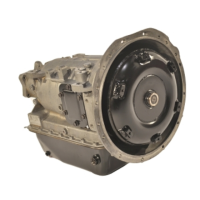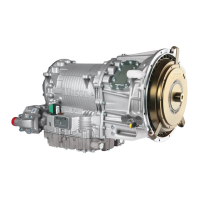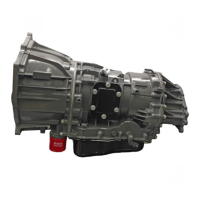2–2 Copyright © 1996 General Motors Corp.
AT 500, 1500 SERIES AUTOMATIC TRANSMISSIONS
stator in the same direction as the turbine and pump.
At this point, torque multiplication stops and the con-
verter becomes, in effect, a fluid coupling.
(6) Thus, the torque converter accomplishes
three main functions. It acts as a disconnect clutch be-
cause little torque is transmitted at engine idle speed.
It multiplies torque at low turbine/high pump speed to
give greater starting or driving effort when needed.
And it acts as a fluid coupling to efficiently transmit
engine torque to the transmission gearing during drive,
other than idle or starting.
(7) For AT 1500 Series models, the engage-
ment of the lockup clutch is controlled by the lockup
relay valve which derives its lockup signal from the
3–4 clutch feed pressure. The clutch apply pressure
compresses the lockup clutch plate against the front
cover. Thus, the converter pump and turbine are
locked together and provide a direct drive from the
engine to the transmission gearing. As rotational
speed of the output shaft decreases, the relay valve
automatically releases the lockup clutch. Refer to
Paragraph 2–19
f
and
g
for explanation of the hydrau-
lic action.
2–6. OIL PUMP ASSEMBLY
a. Description
(Foldout 7,B)
(1) Oil pump assembly 2 includes, in addi-
tion to pump components, front support assembly 17,
main-pressure regulator components 24 through 27,
and, for AT 1500 Series models, lockup valve compo-
nents 30 through 33.
(2) The oil pump consists of driven gear 9
and drive gear 10 which are located in pump body 8.
Pump body 8 is bolted to front support and bearing as-
sembly 16.
(3) The front support assembly includes sta-
tor shaft 19. Front support 21 closes the front of the
transmission and supports the torque converter, turbine
shaft, and forward clutch.
b. Operation
(Foldout 7,B)
(1) When the torque converter is rotating, its
rear hub drives pump drive gear 10. Gear 10 is meshed
with the internal teeth of driven gear 9.
(2) The pump gears draw transmission fluid
from the sump. When the flow of fluid fills all the re-
quirements in the transmission, pressure is developed.
Valve 27 in support 16 regulates the flow of fluid from
the pump.
2–7. FORWARD CLUTCH AND
TURBINE SHAFT
a. Description
(Foldout 8)
(1) The forward clutch and turbine shaft as-
sembly connects the converter turbine to the other
clutches and gearing in the transmission during every
operational phase of the transmission, including PTO
operation or retarder operation.
(2) The turbine shaft is splined to clutch
housing 9 or 14. The external tangs of clutch plates 27
engage housing 9 or 14. The internal splines of clutch
plates 28 engage hub 26 which transmits torque to the
gearing.
(3) Piston 19 is installed in housing 9 or 14
and is retained by sixteen springs 20, retainer 21, and
snapring 22. Clutch plates 27 and 28 are held in hous-
ing 9 or 14 by fourth clutch driving hub 29 and are re-
tained by snapring 30.
(4) Some models are equipped with power
takeoff drive gear 4 or 32. When used, gear 32 is
splined to housing 9 and retained by snapring 31.
When used, gear 4 is splined to housing 9 and retained
by snaprings 3 and 5.
(5) For models with retarder, refer also to
Paragraph 2–16.
b. Operation
(Foldout 8)
(1) Turbine shaft and housing assembly 7 or
11 rotates when the torque converter turbine rotates.
Fourth clutch driving hub 29 also rotates along with
internal-splined fourth clutch plates 3 (Foldout 9,A).
PTO drive gear 4 or 32 (Foldout 8), when included,
also rotates.
(2) When hydraulic pressure is directed to
the piston bore in housing 9 or 14, piston 19 com-
presses clutch plates 27 and 28 against driving hub 29.
This locks clutch hub 26 to housing 9 or 14. Hub 26 is
splined to transmission main shaft 4 (Foldout 10,A).

